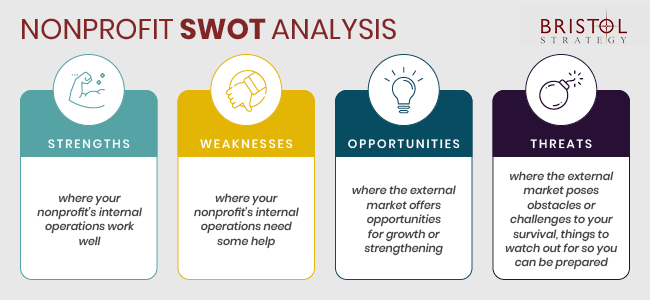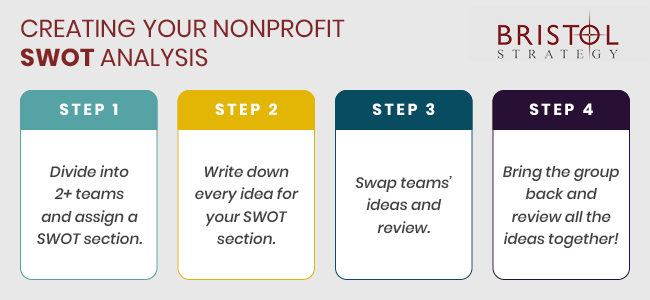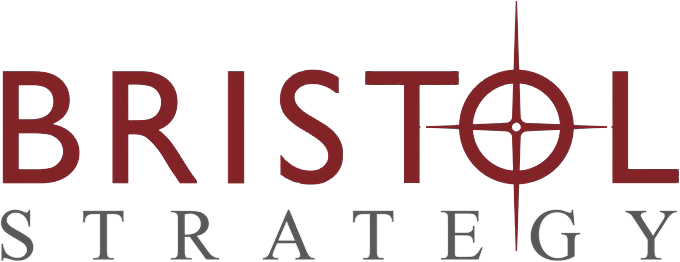According to the Oxford English Dictionary Online, SWOT means “a study undertaken by an organization to identify its internal strengths and weaknesses, as well as its external opportunities and threats.” SWOT analysis was invented for purposes of organizational planning.
A nonprofit SWOT analysis is the same exact thing. Just applied to a nonprofit. Preferably yours.
So why is a fundraising geek talking about SWOT Analysis? Because this fundraising geek, (actually this fundraising management geek) can’t imagine decent fundraising work without effective organizational planning. Fundraising results suffer if they are plagued by inefficient operational processes, unhappy employees, or competitive threats you haven’t recognized.
And there’s another reason. Anyone who invests in your nonprofit takes it for granted that you run the business of your nonprofit thoughtfully, manage the money wisely, have a happy, engaged staff, and are making an impact. Imagine how they’ll feel if (when) they discover things aren’t going so well. So to launch you on this organizational planning journey, we’ll cover:
- What is a Nonprofit SWOT Analysis?
- What does a SWOT Analysis do for Nonprofits?
- How to Conduct a Nonprofit SWOT Analysis
- Takeaways from the Results
What Is a Nonprofit SWOT Analysis?
SWOT is an acronym meaning “Strengths, Weaknesses, Opportunities, Threats.” Lockheed Corporation developed it for corporate planning purposes back in 1952, and corporations of all sizes and sectors, including nonprofits, have used it ever since.
A SWOT analysis for nonprofits is identical to that used by for-profits. The contents will be very different, however. Always remember that while for-profits have several motivations for existing, at least one of them is to make a financial profit. For nonprofits, the overriding objective is to have mission impact. So the SWOT will reveal your organization’s ability to achieve such impact, in a clear and concise manner.
SWOT is often misunderstood and misused so this post is going to demystify the process, and, I hope, make it a habit at your nonprofit.
The SWOT analysis is designed to gain consensus on four things:

- where your nonprofit’s internal operations work well (in other words, your Strengths). For example, let’s say your founding Executive Director is highly regarded in your field and community.
- where they need some help (your Weaknesses). For example, your organization is underfunded.
Please note that sometimes a Strength can be a weakness. For example, the founding ED might also be viewed as a weaknesses, because you have become overly reliant on their “friends and family” to support you.
- where the external market offers opportunities for growth or strengthening (your Opportunities). For example, you focus on chilrden and families, and currently the number of children and families needing your services has grown substantially.
- where the external market poses obstacles or challenges to your survival, things to watch out for so you can be prepared (your Threats). For example, you now face competition from all the other nonprofits in the area seeking to serve those same children and families.
Again, opportunities can be threats, and vice versa. But please note, no characteristic in the “internal” section can also exist in the “external” section.
SWOT Analysis works best f you have many minds collaborating on the exercise. Furthermore, it’s best if you conduct the brainstorming required for your SWOT while you are all in the same room, physical or virtual.
We recommend strongly that you do NOT conduct your SWOT as a survey or as a “first let’s ask Staff Member A to comment, then Staff Member B.”
What Does a SWOT Analysis do for Nonprofits?
SWOT analysis is a planning tool revealing perceptions about the organization’s internal strengths and weaknesses and its external opportunities and threats. Depending on the size of the organization, those involved in the exercise might be everybody who works there, or, if you have a very large team, just a subset.
Having everybody in the room at the same time, as noted above, is extremely powerful. We often find that board members have opinions that differ widely from those of staff. And senior leaders’ opinions may also by quite different from those on the front lines.
When you all come together, you have the invaluable opportunity to hear from one another. As you brainstorm each component of the analysis, you will learn a lot about one another. Capture each comment, even if (or especially if) it differs from others.
For example, some board members might think your fundraising is below par, and are eager for the fundraising team to engage in more events. The board members might say that an internal weakness is “too few fundraising events.”
Capture that comment during the brainstorming session. Later, discuss ways such a comment might not be applicable, including “doesn’t fit our strategy,” or “our data shows we don’t raise enough money to make the XX event worth repeating.”
This exercise gives you and your people a chance to step back and assess where you are today. What’s working? What’s not working? What’s going on in the external market providing opportunities for growth, or threats to your existence?
A Nonprofit SWOT Analysis Reinforces Your Mission Statement
If you have a powerful, motivating mission statement, good for you. But the mission statement alone is not enough to attract and engage philanthropic investors. It simply can’t say everything that’s valuable or appealing about what you do and how you do it. And it can’t, and shouldn’t, reveal your problems.
This is important. The SWOT exercise is a safe place where all participants can express the good, the bad, and the “brutal truths” that need to be heard. Once those perspectives are out on the table, you all can take action to ensure your nonprofit deserves the trust of its clients, staff, board, and investors.
First, use the SWOT to see where you can make operational improvements. Let’s say one of your weaknesses is “insufficient funding.” Now you can all engage in ideas about effective and efficient ways to increase income.
If a board member or prospective donor questions your fundraising results, and you have already put improvements in place, you can safely say “we expect to see improved results in the next (period of time). This way you’re facing the ‘brutal facts’ while showing there is a plan to improve.
If you don’t have the trust of your investors, your nonprofit can’t change the world.
How to Conduct a Nonprofit SWOT Analysis
What You Need for the Analysis
You only need four things:
- People. Participants should represent all aspects of the organization, including senior leadership, finance, fundraising, programming, representatives of the governing board, and maybe even some trusted volunteers or supporters who fit your ideal donor profile.
- Uninterrupted time. A good SWOT exercise requires lots of conversation. Set aside three or four hours where you can work together without interruptions.
- A place to work together. If you can meet in person, find an off-site location to avoid interruptions. If you can only meet virtually, that’s fine as long as you can control the kids, the dogs, and the plumber.
- A way to record comments. Virtual whiteboards, blank Word documents, and flip charts for live meetings all do the job. Do whatever works to capture input.
SWOTs are “top-of-mind” exercises, so you don’t need to bring reams of reports to the table, although a short financial summary is useful. The idea is to get the opinions of your team out of their brains and onto a sheet of paper. If you think this (function, program, process) is working great, but the rest of your team thinks it’s a god-awful mess, you need to know it. They are probably right.
How a Nonprofit SWOT Analysis Works
Once you’ve got your team together and the time and place have been decided upon, get started.

- Divide your group into two or more teams.
- Using either breakout rooms (virtual) or separate flip-chart pads (live), have each team tackle either the Internal Strengths and Weaknesses, or the External Opportunities and Threats. Give the teams about ten minutes to write down every idea they can think of related to their assignment. Remind them of the rules:
- Internal stuff, the S and W, includes staffing, processes, technology, marketing, finances, leadership, board, and the color of your t-shirts. Some of those are strengths, others are weaknesses, and some belong in both categories.
- External stuff, the O and T, includes people moving into your geography, a rise in government funding, heightened awareness of causes like yours due to something in the news, newly elected officials who are unsympathetic to your cause. Some of these are opportunities, some are threats, and some belong in both categories.
- Strengths can be Weaknesses, and Threats can be Opportunities, but Internal matters can never be External, and External matters can never be internal.
- No fighting.
- At the end of the allotted time, ask the breakout teams to switch from their assignment to the other team’s assignment. Then give them just five more minutes to review the first team’s results and add any new ideas they might have. This way, you get perspectives from everyone on the whole S, W, O, and T.
- Less is more. In this case, giving the teams LESS time will produce MORE and BETTER results.
- Bring the whole group back together to review the four lists and remove duplicates. If any Internal items wandered into the External set, put them back where they belong.
Find more details conducting a successful SWOT analysis in our book Success Planning for Nonprofits: Evidence-Based Strategic Planning.
Takeaways from the Results
SWOT Analysis is the basis of effective planning because it makes the invisible, visible. The diverse perspectives of your participants bring to light issues that you may have become blind to, or thought, “Meh? We can live with it.” Now that you can see what’s working or not, you take action. Right?
This is where too many nonprofits flunk SWOT Analysis, so let’s avoid the problem. You’ve gone to a great deal of effort to identify the four components. Now what are you going to do with the information?
Well, the first thing you’re going to do is to trust the process. Inevitably, as long as the group has enough people and perspectives, the information gathered is both valuable and accurate for planning purposes, even if some of it makes you uncomfortable.
Each of the four components launches the planning process by identifying what’s working internally and what’s not; by showing what’s going on in the outside world that could benefit your nonprofit, and what poses a potential threat to growth or even survival. Oftentimes, the internal Weaknesses are the most pressing issues to address, even or especially if they are unflattering.
The second thing you’re going to do is to prioritize the issues. We encourage doing something called the “Force-Field Exercise,” geek-speak for comparing Strengths to Weaknesses (and ditto for Opportunities and Threats). Compare the two internal categories and ask “which of these Weaknesses are covered by a Strength?” If there are Weaknesses not covered, or managed by, a Strength, then come to consensus on how damaging the weakness might be and give it a high planning priority.
You don’t need to solve the problem yet; you’ve done yourself a favor by simply selecting the issue as one that justifies immediate attention. Repeat the process for external Opportunities and Threats. By the way, during this process, prioritize Strengths and Opportunities that justify immediate attention as well. Good planning always starts by emphasizing one’s strengths!
Now that you have identified the high-priority issues, start thinking about your organization’s strategic goals and objectives. If you have already defined them, insights from a well-run SWOT might encourage you to rethink or re-prioritize them. If you have NOT already done so, use the prioritized SWOT to aid you in developing high-level goals and objectives.
Benefits of the SWOT Analysis
There’s nothing like planning from a basis of facts and informed perspectives. That’s what a good SWOT provides your nonprofit. There are many long-term benefits from this exercise.
- Board and staff become more collegial as they get to know each others’ perspectives.
- Making the SWOT Analysis an annual event, along with the annual review of your strategic plan, creates a standard of excellence in your operations.
- The annual review also helps to institute the concept of continuous improvement, where all stakeholders are engaged in improving the methods that demonstrate improved mission impact.


